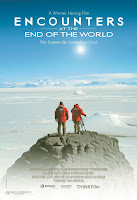Director: Guillermo Del Toro
Cast: Idris Elba, Charlie Hunnam, Rinko
Kikuchi
The
real summer blockbuster of 2013, and when it comes to the “big and monstrous” Pacific
Rim dwarfs anything ever produced by the likes of “The Avengers” or any other
big-budget extravaganza.
Film
uses a very basic plot—heroes defending the planet against invading
aliens coming through an undersea portal between our world and another
dimension. Del Toro reintroduces Kaiju—monolithic monsters (such as Godzilla)
wrecking havoc on the planet, and mankind’s only defense against them,
Jaeger—kind of ostentatiously large version of Iron Man armor controlled neutrally
by a human pilot, the evolved versions use two pilots sharing the neural load
by psychically bridging their minds through a technique called “drifting”.
Loaded
with some ultra-cool weaponry (like Plasma gun, Rocket Elbow, Missile Launcher,
Hammer) Jaeger’s best was indeed the good, old Sword--only a tad bigger! The
two scenes with swordplay—one mid-air, one underwater—simply blow you away,
would have loved seeing more of it—hopefully in the upcoming sequel!
A
lot of films tried capturing the ‘grandiose’ of comics or graphic novels—especially
the colossal alien villains—but it is Del Toro who has hit the mark closest,
yet. Jaeger’s designs, including its gait, movement and fights were perfect in
all its grandeur. Kaiju could use little more refinement/clarity when it comes
to dark and shady underwater scenes.
In
all, Pacific Rim has raised the bar very high when it comes to spectacularly grand
designs and visual effects—Del Toro accomplished his vision onscreen by
collaborating with some proven artists of the field.
His
coterie included: robot and monster designers Wayne Barlowe, Oscar Chichoni, David Meng and Simon
Lee,
and Francisco Ruiz Velasco, famed for Hellboy II and The Hobbit. Special
effects were handled by John Knoll and Hal T. Hickel ( Star Wars and Pirates of the Caribbean),
Shane Mahan (Iron Man), John Rosengrant (Real Steel) and Clay Pinney (Independence Day, Star Trek). No wonders the
awesomeness that transpired on onscreen was a visual treat like never before.
Even though a second fiddle, the
star cast delivers as it was expected to. Idris Elba was impressive as a hard-boiled
leader, Charlie Day and Ron Perlman provide the much needed gags at the right
moments and Charlie Hunnam looked good too (perhaps his meatiest role since Green
Street Hooligans).
Calls
for a definite theater watch!
8.1/10




